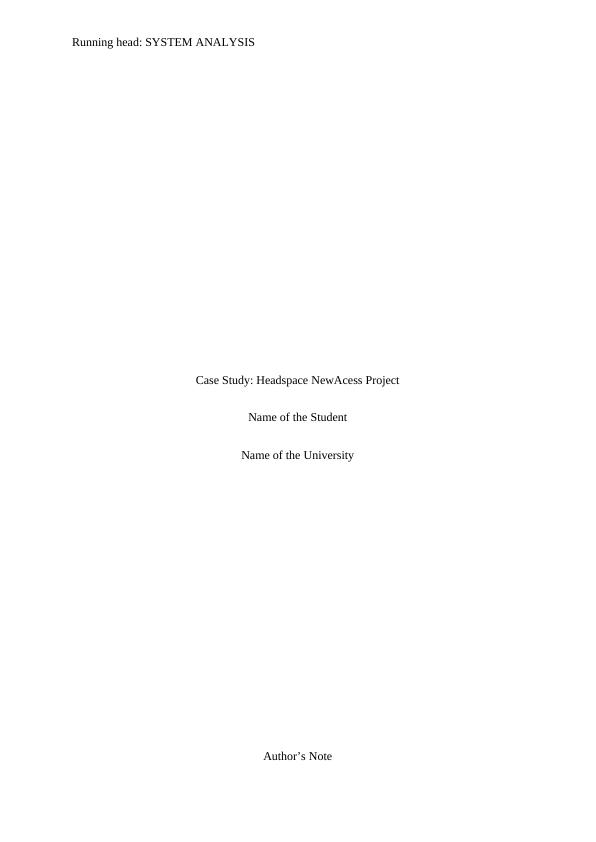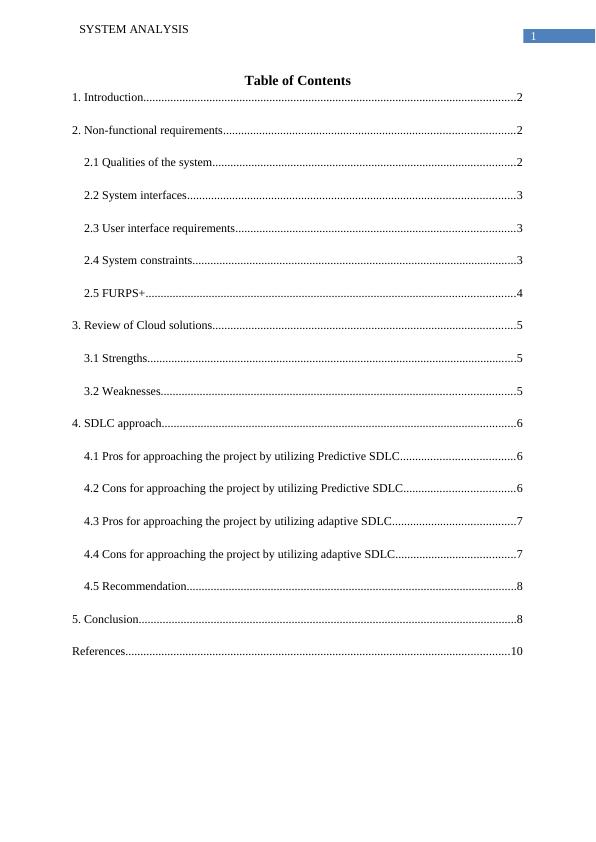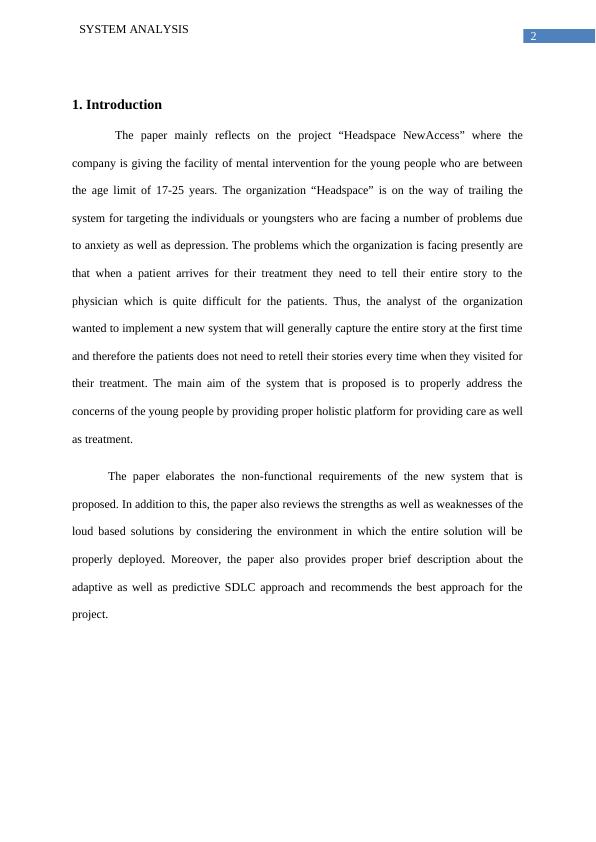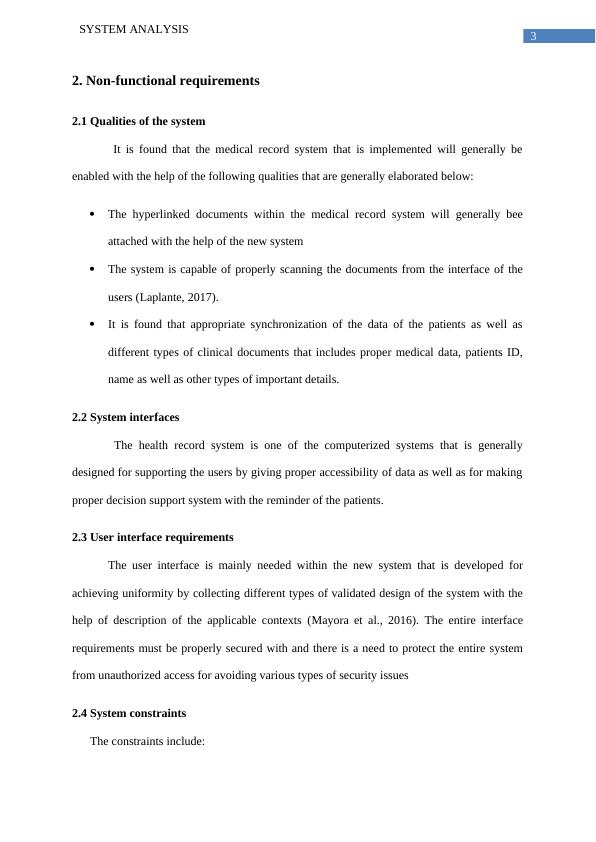System Analysis
Added on 2023-04-04
12 Pages2307 Words116 Views
Running head: SYSTEM ANALYSIS
Case Study: Headspace NewAcess Project
Name of the Student
Name of the University
Author’s Note
Case Study: Headspace NewAcess Project
Name of the Student
Name of the University
Author’s Note

1
SYSTEM ANALYSIS
Table of Contents
1. Introduction............................................................................................................................2
2. Non-functional requirements.................................................................................................2
2.1 Qualities of the system.....................................................................................................2
2.2 System interfaces.............................................................................................................3
2.3 User interface requirements.............................................................................................3
2.4 System constraints............................................................................................................3
2.5 FURPS+...........................................................................................................................4
3. Review of Cloud solutions.....................................................................................................5
3.1 Strengths...........................................................................................................................5
3.2 Weaknesses......................................................................................................................5
4. SDLC approach......................................................................................................................6
4.1 Pros for approaching the project by utilizing Predictive SDLC......................................6
4.2 Cons for approaching the project by utilizing Predictive SDLC.....................................6
4.3 Pros for approaching the project by utilizing adaptive SDLC.........................................7
4.4 Cons for approaching the project by utilizing adaptive SDLC........................................7
4.5 Recommendation..............................................................................................................8
5. Conclusion..............................................................................................................................8
References................................................................................................................................10
SYSTEM ANALYSIS
Table of Contents
1. Introduction............................................................................................................................2
2. Non-functional requirements.................................................................................................2
2.1 Qualities of the system.....................................................................................................2
2.2 System interfaces.............................................................................................................3
2.3 User interface requirements.............................................................................................3
2.4 System constraints............................................................................................................3
2.5 FURPS+...........................................................................................................................4
3. Review of Cloud solutions.....................................................................................................5
3.1 Strengths...........................................................................................................................5
3.2 Weaknesses......................................................................................................................5
4. SDLC approach......................................................................................................................6
4.1 Pros for approaching the project by utilizing Predictive SDLC......................................6
4.2 Cons for approaching the project by utilizing Predictive SDLC.....................................6
4.3 Pros for approaching the project by utilizing adaptive SDLC.........................................7
4.4 Cons for approaching the project by utilizing adaptive SDLC........................................7
4.5 Recommendation..............................................................................................................8
5. Conclusion..............................................................................................................................8
References................................................................................................................................10

2
SYSTEM ANALYSIS
1. Introduction
The paper mainly reflects on the project “Headspace NewAccess” where the
company is giving the facility of mental intervention for the young people who are between
the age limit of 17-25 years. The organization “Headspace” is on the way of trailing the
system for targeting the individuals or youngsters who are facing a number of problems due
to anxiety as well as depression. The problems which the organization is facing presently are
that when a patient arrives for their treatment they need to tell their entire story to the
physician which is quite difficult for the patients. Thus, the analyst of the organization
wanted to implement a new system that will generally capture the entire story at the first time
and therefore the patients does not need to retell their stories every time when they visited for
their treatment. The main aim of the system that is proposed is to properly address the
concerns of the young people by providing proper holistic platform for providing care as well
as treatment.
The paper elaborates the non-functional requirements of the new system that is
proposed. In addition to this, the paper also reviews the strengths as well as weaknesses of the
loud based solutions by considering the environment in which the entire solution will be
properly deployed. Moreover, the paper also provides proper brief description about the
adaptive as well as predictive SDLC approach and recommends the best approach for the
project.
SYSTEM ANALYSIS
1. Introduction
The paper mainly reflects on the project “Headspace NewAccess” where the
company is giving the facility of mental intervention for the young people who are between
the age limit of 17-25 years. The organization “Headspace” is on the way of trailing the
system for targeting the individuals or youngsters who are facing a number of problems due
to anxiety as well as depression. The problems which the organization is facing presently are
that when a patient arrives for their treatment they need to tell their entire story to the
physician which is quite difficult for the patients. Thus, the analyst of the organization
wanted to implement a new system that will generally capture the entire story at the first time
and therefore the patients does not need to retell their stories every time when they visited for
their treatment. The main aim of the system that is proposed is to properly address the
concerns of the young people by providing proper holistic platform for providing care as well
as treatment.
The paper elaborates the non-functional requirements of the new system that is
proposed. In addition to this, the paper also reviews the strengths as well as weaknesses of the
loud based solutions by considering the environment in which the entire solution will be
properly deployed. Moreover, the paper also provides proper brief description about the
adaptive as well as predictive SDLC approach and recommends the best approach for the
project.

3
SYSTEM ANALYSIS
2. Non-functional requirements
2.1 Qualities of the system
It is found that the medical record system that is implemented will generally be
enabled with the help of the following qualities that are generally elaborated below:
The hyperlinked documents within the medical record system will generally bee
attached with the help of the new system
The system is capable of properly scanning the documents from the interface of the
users (Laplante, 2017).
It is found that appropriate synchronization of the data of the patients as well as
different types of clinical documents that includes proper medical data, patients ID,
name as well as other types of important details.
2.2 System interfaces
The health record system is one of the computerized systems that is generally
designed for supporting the users by giving proper accessibility of data as well as for making
proper decision support system with the reminder of the patients.
2.3 User interface requirements
The user interface is mainly needed within the new system that is developed for
achieving uniformity by collecting different types of validated design of the system with the
help of description of the applicable contexts (Mayora et al., 2016). The entire interface
requirements must be properly secured with and there is a need to protect the entire system
from unauthorized access for avoiding various types of security issues
2.4 System constraints
The constraints include:
SYSTEM ANALYSIS
2. Non-functional requirements
2.1 Qualities of the system
It is found that the medical record system that is implemented will generally be
enabled with the help of the following qualities that are generally elaborated below:
The hyperlinked documents within the medical record system will generally bee
attached with the help of the new system
The system is capable of properly scanning the documents from the interface of the
users (Laplante, 2017).
It is found that appropriate synchronization of the data of the patients as well as
different types of clinical documents that includes proper medical data, patients ID,
name as well as other types of important details.
2.2 System interfaces
The health record system is one of the computerized systems that is generally
designed for supporting the users by giving proper accessibility of data as well as for making
proper decision support system with the reminder of the patients.
2.3 User interface requirements
The user interface is mainly needed within the new system that is developed for
achieving uniformity by collecting different types of validated design of the system with the
help of description of the applicable contexts (Mayora et al., 2016). The entire interface
requirements must be properly secured with and there is a need to protect the entire system
from unauthorized access for avoiding various types of security issues
2.4 System constraints
The constraints include:

End of preview
Want to access all the pages? Upload your documents or become a member.
Related Documents
Headspace Newaccess Project 2022lg...
|12
|2731
|5
Headspace NewAccess Projectlg...
|12
|2020
|277
The Discussion of Headspace Company | Reportlg...
|9
|1862
|49
Cloud-based Assignment on Headspace Companylg...
|9
|2062
|44
Non Functional System Requirementslg...
|12
|2738
|143
System Analysis and Design Assessmentlg...
|11
|2339
|67